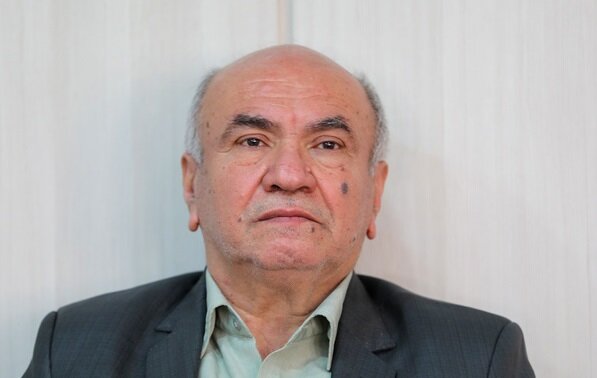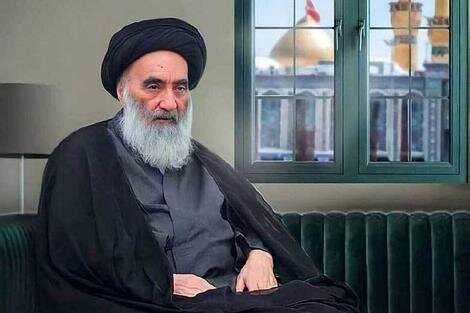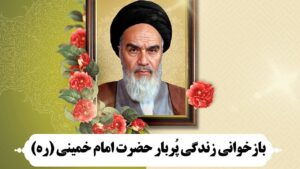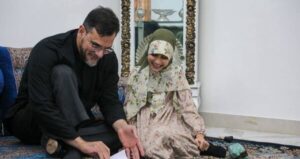Dr. Ali Mohammad Hashedi, university professor and faculty member of Tarbiat Modares University, has written about his recent meeting with Grand Ayatollah Sistani from the Supreme Authority of Najaf in Ashraf city. to report Missionary thought and culture baseIt is stated in this article:
“The death of her beloved mother in the courtyard of Hazrat Seyyed al-Shahda’s holy shrine and her burial in Karbala made it possible for us to go to Atbat together with sixty other relatives and friends on the occasion of the 40th anniversary of the deceased. We entered Najaf Ashraf on the evening of Thursday, July 20, 2007, and unexpectedly, I was the only one of the group of 60 people who managed to meet Ayatollah Sistani.

What follows is the report published in ISNA about this meeting:
It was at 8 am on Friday, July 21, when we found out that Ayatollah Sistani might have a meeting today. It was 9 o’clock in the morning when we went to the hotel manager to get the address, and they said that you must have a passport, and the passports were handed over to the caravan manager, which finally turned out to be the hotel manager’s hand, and he asked for my three passports, my son Javad’s and Mr. Mozaffarinejad’s passports. We took it from him and quickly went to his office, which was about 100 meters from the shrine. In addition to other nationalities, there were about 100 Iranians standing in line, and when Abu Jamal Mosul or the contact of the Iranians of the office came, they all went to him. Of course, at the same time, different groups of people from Iraq and the Persian Gulf countries were easily and in large numbers directed to the office. Abu Jamal started to take the passports that were presented to him by the rush of the crowd. After taking about 15 passports, he said it was over. 20 people had given me permission to take it. Request from us and refuse from him that the capacity is full. After seeing the passports in his hand, I guessed that these are not 20. He said that I have already noted the names of three people. Finally, he agreed to take another one out of the three passports in my hand, and I suggested Mr. Mozaffarinejad. He was magnanimous and insisted that I give my passport, and I, who was very eager for this visit, took advantage of his kindness and handed over my passport. He said to be here at a quarter to eleven. We had about an hour and a half to agree. The imam’s very humble house, whose area was definitely less than 100 meters, was completely destroyed due to wear and tear and lack of care, and only the entrance was left on the wall. With great regret, we saw the ruins and Mr. Mozafarinejad, who apparently had visited that house a few years ago, and showed the location of the guest room and Imam’s office from the remains on the walls. After this visit, with the guidance of a local person who apparently lived through such guidance, we were directed to the house of Allameh Amini – the owner of the precious work of Al-Ghadir – and his burial place, which was 150 meters away from Beit Imam. His house was also about 100 cubic meters bigger than the Imam’s house and to some extent of better quality, which still seemed healthy. His tomb was also located in the building on the opposite side of the alley, which was apparently his research office. We honored his memory by reciting Fatiha. After that, the guide led us to the Sheikh Ansari Mosque, which was the place where the Imam (RA) taught. It was relatively well maintained and he showed us the pulpit from which the Imam used to present his religious authority and other lessons. became.
While I was reviewing the influence and influence of this forum and pulpit in my mind, the hands of the clock warned that we should quickly move towards Ayatollah Sistani’s office. We arrived at Ayatollah Sistani’s office a few minutes before the scheduled time, and Abu Jamal led us to the office at 10:45.
The main office was located at a distance of about 30 meters from the main street and inside a narrow alley of 1.5 meters. During this 30-meter route, there were 6 relatively detailed physical inspection points, which of course were inspected carefully with politeness and apologetics. The first one was the handover place where we used to hand over money, passports, and other items. Inside the office was a small area that was surrounded by several rooms of about 30 meters, and apparently clients from different nationalities or regions were directed to those rooms separately. We Iranians were directed to one of these rooms, which led from the inside to the meeting room; A very simple room, the walls of which were painted oil up to about 1.5 meters and above that were painted plastic. The floor of the room was a carpet, and there were mats all around it, and matkas or pillows were placed on them.
After a few minutes, about 17 of us entered the room. People were served with a narrow-waisted glass of tea and sugar. The waiter and waitress politely and respectfully brought a glass of tea to each new arrival. At 11 o’clock from the inner door of the same room which was an iron door, we were led to the main room where Ayatollah Sistani resides. He was in the corner of the room next to a small desk that we had seen a similar photo of in the Imam and Mr. Sistani’s office, and now there was only a pack of paper towels on it, on a mat They were sitting like the rest of the mats around the room. The guests were allowed to go near him and shake hands with him while sitting. Two watchers or protectors were standing on either side of them, preventing them from getting closer. After losing the present crowd, he circled in front of him. The three clerics present in the gathering were at the closest distance and the rest were after them. After Ayatollah Sistani’s guests sat down, after greeting and briefly welcoming the attendees, they asked each person about their name, city of residence and occupation, and other questions were asked according to the answers. left:
The first person was Seyed Rouhani, a young man who came from Borujerd and said that he had studied up to the level and that apart from studying, he also preaches.
Ayatollah asked, what have you read that you are promoting? He mentioned the same few usual textbooks. They said that this is an introduction to education and has nothing for the people. They asked again if there is no need for preparations and permission to advertise? Do you have the permission that the person himself and the clergyman at hand answered that they have received permission from the advertising office and are sent on their behalf to advertise. Ayatollah Sistani said ironically: In any case, apart from these official permissions, you should feel that you have something to say to the people, and your words will really be propagating the religion and teachings of the Ahl al-Bayt, otherwise it will violate the intention.
The second cleric was a middle-aged Sayyid from Isfahan who said: I also go to school, I am the imam of the congregation, and I also have a mosque and a pulpit. They asked: Where are you going to study? He answered: Ayatollah Mazaheri’s lesson.
The next person introduced himself as he had the experience of attending the foreign courses of several scholars and is currently a professor of Islamic studies, Islamic history and Islamic ethics at the university.
Ayatollah Sistani said: Well, you must have a very strong foundation in all the subjects you teach in the university, otherwise not everyone can teach so many different subjects in the university.
They asked after the name of the university where he taught, and he answered, Imam Muhammad Baqer University of Ray city. Ayatollah asked the same university that is under the leadership of Mr. Mahdavi Kenny, who answered no, it is under the supervision of Mr. Ray Shahri.
At this time, the person in question asked for permission to say something else, and they told him to keep it short. He started to pray for scholars, references and servants to Islam and used this interpretation that God willing, we can serve under your shadow. When he used the word “your shadow”, Ayatollah interrupted him and told him not to speak in this way. We don’t have a shadow that anyone is under. You say you are a university professor. Be careful not to learn and use such interpretations at all. We may believe it ourselves.
The next people introduced themselves from the people of Ardabil and Mako, who are engaged in agriculture and animal husbandry.
Ayatollah Sistani, thanking the efforts of this group, asked about the rain and drought conditions, to which those people replied, Alhamdulillah, there has been good rain for the past few days and the problem has been solved to some extent.
Several people introduced themselves as residents of Tehran, including myself. Ayatollah said that Tehran is the center of government and Alhamdulillah is in good condition and there is no reason to ask any questions about it, so that it can be used to search the affairs of officials.
They indicated that they would like to know more about deprived areas. Then they brought up, unfortunately, most of the areas far from the center and the edges of the borders are deprived, and they said that even though the border areas are considered like the wall of the house, and we must build this fence strong and high so that the funds inside the house are protected, but we go inside more. We arrive and neglect the fence and border areas.
A few people introduced themselves from the residents of Sistan and Baluchistan and the cities of Zahedan and Zabul, who were greeted more carefully and asked about the functioning of the charity institutions and clinics established by the Ayatollah in Zabul, and those people expressed their satisfaction. they did They also expressed regret about the drought and lack of water in the region and attributed it to the closing of Hirmand water in the former regime of Iran and Afghanistan.
Some people in the region were forced to sell their houses due to the existing conditions, and one of the people in the crowd said that we are forced to sell because there is no income in the region and there are many problems. Therefore, when they offer a good price, we have to sell. Ayatollah said in a rather reprimanding tone, don’t say we are forced, there is no such thing as coercion. When a Muslim person feels that his religious duty and belief requires something, even if he has some problems, he should bear the problems and not do anything that the enemies will benefit from. It was here that in order to encourage these brothers to endure hardships, they said that I am nobody, but since I felt that through the grace of the people and the care of the Almighty, my presence might be a stumbling block for the enemies, I endured the hardships here, which you must know about. I could have gone to other places, but I didn’t. I have not left Najaf for several years now. Even recently, when I went abroad for treatment, due to the issues that happened to Iraq, and you know more than that, I left the treatment course unfinished and returned to Najaf, and now it has been a long time since I even walked a few steps to visit the Holy Prophet. I have not succeeded either.
Ayatollah Sistani added: Don’t think that this mansion you see is my home. No, we have prepared this for people like you. My house is an old rented house of 70 meters. I shouldn’t say these things, but since you said that you may have to leave the country, I say that you should bear the problems. At the end of the meeting, one of the attendees asked to give some advice. Ayatollah Sistani said: I am not saying anything special. In the past, others are waiting and we are getting close to the time of prayer, but since you asked me to say this much, the world is not left for anyone. You yourself feel what work is for God’s pleasure and is useful for your future. Try to do this type of work more often.
The visit ended in a situation where I am left with a longing to understand the reasons for the spiritual influence of such personalities. I had previously understood the height of the Imam’s influence in the reports and memories of others, and once I had the opportunity to be in the crowd of visitors in Hosseinieh Jamaran. The fact that it was a public meeting and no private communication was established, the greatness of that meeting is still prominent in my mind, but there was also a difference here, and that is that Hazrat Ayatollah Sistani looked completely normal in terms of his physical appearance and facial features, but still his influence on the audience. It was impressive.
In a word, what I can say is that the memory of this meeting had combined the paradox of greatness and simplicity as well as intelligence and unpretentiousness, and I am still drunk on the potion of this combination.
Ali Mohammad Hashedi”
منبع: www.khabaronline.ir




